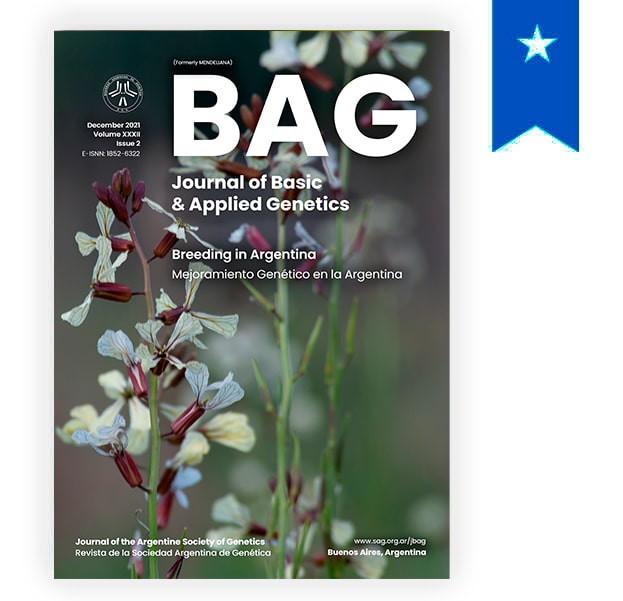Ver ítem
- xmlui.general.dspace_homeCentros Regionales y EEAsCentro Regional Santa FeEEA OliverosArtículos científicosxmlui.ArtifactBrowser.ItemViewer.trail
- Inicio
- Centros Regionales y EEAs
- Centro Regional Santa Fe
- EEA Oliveros
- Artículos científicos
- Ver ítem
Aplicación de diferentes metodologías en el mejoramiento de lenteja (Lens culinaris Medik) = Application of different methodologies in lentil (Lens culinaris Medik) breeding
Resumen
La lenteja (Lens culinaris Medik.) es una especie diploide autógama (2n=2x=14) perteneciente a la familia Fabaceae. Es uno de los cultivos más antiguos que se conocen, con 8.000 a 9.000 años de historia, y se encuentra entre los primeros domesticados en Medio Oriente. Las semillas tienen un alto valor nutricional. Este cultivo es un interesante sustituto del trigo en las rotaciones de cereales, pero su importancia es baja debido a la falta de buenas
[ver mas...]
La lenteja (Lens culinaris Medik.) es una especie diploide autógama (2n=2x=14) perteneciente a la familia Fabaceae. Es uno de los cultivos más antiguos que se conocen, con 8.000 a 9.000 años de historia, y se encuentra entre los primeros domesticados en Medio Oriente. Las semillas tienen un alto valor nutricional. Este cultivo es un interesante sustituto del trigo en las rotaciones de cereales, pero su importancia es baja debido a la falta de buenas variedades con adaptación local. Uno de los principales problemas que enfrentan los mejoradores en nuestro país es la estrecha base genética del germoplasma cultivado y su bajo potencial de rendimiento. En 2004 se inició un programa de mejoramiento de lentejas para desarrollar nuevas variedades con adaptación a las condiciones predominantes en las áreas de cultivo de Argentina. El germoplasma se obtuvo del ICARDA (Centro Internacional de Investigación Agrícola en las Zonas Áridas) y de productores locales. Se utilizan métodos convencionales de mejoramiento basados en la hibridación y selección. Se han obtenido dos nuevas variedades, una del tipo macrosperma (Boyerito FCA) y la otra del tipo microsperma (Tacuarita FCA) mediante la aplicación de selección masal en poblaciones F2 provenientes de la hibridación de materiales seleccionados. Este programa complementa los métodos de mejora tradicional con técnicas biotecnológicas como la transgénesis, el uso de marcadores moleculares, el cultivo de embriones in vitro combinado con el método SSD para acortar el ciclo generacional, y el fenotipado digital.
[Cerrar]
Lentil (Lens culinaris Medik.) is a self-pollinating diploid (2n=2x=14) species belonging to the Fabaceae family. It is one of the oldest crops known, with 8,000 to 9,000 years of history and it is among the earliest domesticates from the Near East Fertile Crescent. The seeds have high nutritional value. This crop is an interesting substitute to wheat in cereal rotations but its importance is low due to a lack of suitable varieties with local adaptation.
[ver mas...]
Lentil (Lens culinaris Medik.) is a self-pollinating diploid (2n=2x=14) species belonging to the Fabaceae family. It is one of the oldest crops known, with 8,000 to 9,000 years of history and it is among the earliest domesticates from the Near East Fertile Crescent. The seeds have high nutritional value. This crop is an interesting substitute to wheat in cereal rotations but its importance is low due to a lack of suitable varieties with local adaptation. Some of the major problems that Argentinian lentil breeders face are the narrow genetic base of the current cultivated germplasm and its low yield potential. A lentil breeding program was initiated in 2004 to develop new varieties with adaptation to prevalent conditions in growing areas of Argentina. Germplasm was obtained from ICARDA (International Center for Agricultural Research in the Dry Areas) and local producers. Conventional breeding methods using hybridization and selection are being carried out to develop improved varieties, broad the genetic base, and isolate superior recombinant inbred lines. Two new varieties have been obtained, one of the macrosperm type (Boyerito FCA) and the other of the microsperm type (Tacuarita FCA) through the application of mass selection in F2 populations from the cross of selected materials. This program complements traditional breeding methods with biotechnological techniques such as transgenesis, use of molecular markers, in vitro embryo culture combined with the SSD method to shorten the breeding time, and digital phenotyping.
[Cerrar]

Autor
Bermejo, Carolina J.;
Maglia, Fernando;
Palacios Martínez, Laura Tatiana;
Esposito, Maria Andrea;
Cazzola, Federico;
Guindon, María Fernanda;
Gatti, Ileana;
Cointry, Enrique Luis;
Fuente
BAG. Journal of basic and applied genetics 32 (2) : 33-40. (Dic. 2021)
Fecha
2021-12
Editorial
Sociedad Argentina de Genética
ISSN
1852-6233
Formato
pdf
Tipo de documento
artículo
Palabras Claves
Derechos de acceso
Abierto
 Excepto donde se diga explicitamente, este item se publica bajo la siguiente descripción: Creative Commons Attribution-NonCommercial-ShareAlike 2.5 Unported (CC BY-NC-SA 2.5)
Excepto donde se diga explicitamente, este item se publica bajo la siguiente descripción: Creative Commons Attribution-NonCommercial-ShareAlike 2.5 Unported (CC BY-NC-SA 2.5)


